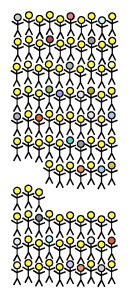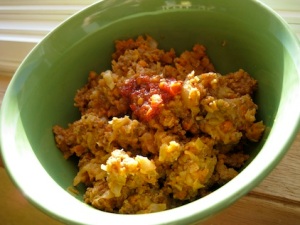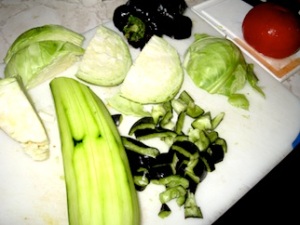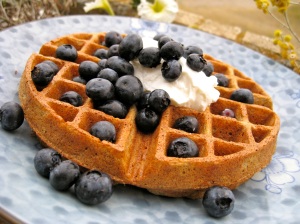Your blood test was negative? That sounds good. Did you consult a gastroenterologist about your gut pain, fatigue, or anemia? No? oh. You let your general physician interpret your results? I see. What if I told you that you still don’t really know if you have celiac disease or not?
We are always reassured by doctors about how great the latest test is, how sensitive and accurate, etc. until a better test comes along, whatever ailment. But, as it turns out, the tTg is not the be-all-and-end-all of testing for celiac disease and definitely not for catching gluten-sensitivity or any preventative measures or pre-celiac intolerance. (Celiac disease is defined by intestinal damage that’s already happened; you can’t find it before it happens so there’s no good definition for preventing it yet.)

100 w/Severe Damage
Pretend the group of 100 stick figures on the right are 100 people with severe small intestine damage from celiac disease. Take blood from each of them and run the typical celiac blood tests. Most labs use the anti-tTg test which looks for Anti-tissue Transglutaminase Antibodies. These antibodies represent immune system attack at the level of the intestinal lining. There’s a minuscule chance that some other disease besides celiac will give a positive tTg so if you have a positive on this test, you most likely have celiac disease. But if you have a negative on this test, does that mean you definitely don’t have celiac disease? No.
See how I divided these 100 celiacs into one group of 23 at the top and the other 77 at the bottom? Those top 23 people, who still have severe small intestine damage, have received a false negative on their tTg blood test. Those people have severe damage in their small intestines! (“Severe” means this leads to massive lack of absorption of nutrients, high risk for cancers esp. of the bowels, etc) Almost a quarter of celiacs with severe damage are being missed when using the tTg. Will they still get diagnosed? That depends on many things, doesn’t it? Whether their doctors understand that the tTg is not perfect is a big factor I should think. I know several people who have symptoms, go and get the blood test, get a negative and then proclaim themselves not celiacs only to go on with many possible symptoms and getting diagnoses like IBS, fibromyalgia, and the like. Get yourself to a good gastroenterologist, pronto!
Here’s another group of 100 stick figures people who have celiac disease but only partial damage to their small intestines, this means it’s spotty and might even be tricky to find with a few biopsy samples. Give them the same blood tests, using tTg as the main indicator of celiac disease. See the large upper group of 67? That’s how many will get false negative blood tests using tTg. Only the lower group of 33 will be correctly identified as having celiac disease if only the tTg is relied upon.

100 w/Partial Damage
In my extended family (first and second degree relatives) we have three diagnosed celiacs: one by positive tTg and biopsy, one with negative tTg but positive biopsy, and one by high tTg plus her relationship to the previous two and improvement on the gluten-free diet. We have another self-diagnosed gluten-intolerant in the ranks but her daughter had the high tTg with no biopsy so we accept the self diagnosis. In other members of my family and in my circle of friends and acquaintances, there are so many possible symptoms but their GPs are relying on the tTg and I don’t think that’s the best choice in many cases. There are no small intestine biopsies being done on symptomatic individuals related to celiacs. There are no biopsies being done on the lesioned skin of family members with first degree relations to celiacs who have dermatitis herpetiformis. Drives me nuts. No wonder there are still two and a half million undiagnosed celiacs in the USA alone, for any 200 people with severe and partial small intestine damage, 90 are very likely not getting diagnosed – nearly half will not get diagnosed if we rely solely on the tTg. If I had more time I’d make those top 67 on the right have little frowny faces.
I will grant you that some of those 100 people on the right might get negative biopsies too. The small intestine, if laid out flat, is as large as a tennis court so getting a biopsy of exactly the right spots of damage just might not happen. In that case, some patients still might be encouraged by a gastroenterologist to try a gluten-free diet and then based on the response to that get a diagnosis or not. The GPs and gastros I’ve seen so far are all supportive of using a trial on the gluten-free diet to assess a patient.
Why not just try a gluten-free diet, you ask? Ok by me. I don’t have a problem with that as long as you really and truly do the diet to the letter: learn where hidden gluten is and avoid it. Don’t eat in restaurants often, don’t eat the french fries fried in the same oil as the bloomin’ onion, don’t eat the tortilla chips fried in the same oil as flour tortilla chimichangas, don’t assume that soy sauce is just made of soy. I could go on but just do the research. And know that if you go on a gluten-free diet you will not be able to get valid testing in the future without eating a lot of gluten for quite a while.
I am extrapolating from this research that only looked at 115 known celiacs so there will be some variation. But how much? And are you willing to risk your health or your child’s health on that variation? It’s your call.
And guess what? There’s a newer test. And so far we’re told it’s better than the tTg at detecting celiac disease. Or not. In short it’s called the DGP (a little longer: IgA/IgG-DGP.) If you have an endless supply of money, you could try that test.
I don’t think there are often easy answers to the question of whether a person with symptoms has gluten intolerance or not. A good gastro will have you try a gluten free diet if he/she is paying attention to all the research on celiac and non-celiac gluten sensitivity. I hope you find a good one.







